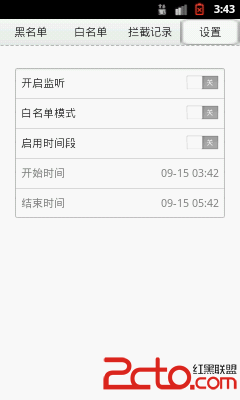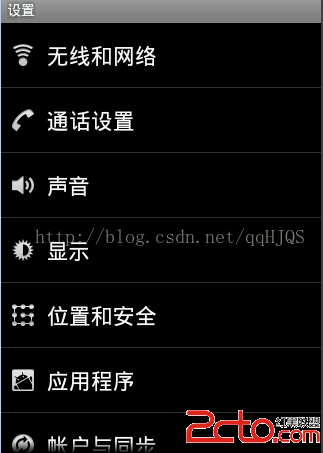編輯:關於Android編程
Android widget 桌面組件開發
Widget是Android1.5版所引進的特性之一.Widget,可讓用戶在主屏幕界面及時了解程序顯示的重要信息.標准的Android系統已包含幾個Widget的示例,如模擬時鐘,音樂播放器等.
一、AppWidget 框架類
1、AppWidgetProvider :繼承自 BroadcastRecevier , 在AppWidget 應用 update、enable、disable 和 delete 時接收通知。其中,onUpdate、onReceive 是最常用到的方法,它們接收更新通知。
2、 AppWidgetProvderInfo:描述 AppWidget 的大小、更新頻率和初始界面等信息,以XML 文件形式存在於應用的 res/xml/目錄下。
3、AppWidgetManger :負責管理 AppWidget ,向 AppwidgetProvider 發送通知。
4、RemoteViews :一個可以在其他應用進程中運行的類,向 AppWidgetProvider 發送通知。
二、AppWidget 框架的主要類介紹
1) AppWidgetManger 類
bindAppWidgetId(int appWidgetId, ComponentName provider)
通過給定的ComponentName 綁定appWidgetId
getAppWidgetIds(ComponentName provider)
通過給定的ComponentName 獲取AppWidgetId
getAppWidgetInfo(int appWidgetId)
通過AppWidgetId 獲取 AppWidget 信息
getInstalledProviders()
返回一個List<AppWidgetProviderInfo>的信息
getInstance(Context context)
獲取 AppWidgetManger 實例使用的上下文對象
updateAppWidget(int[] appWidgetIds, RemoteViews views)
通過appWidgetId 對傳進來的 RemoteView 進行修改,並重新刷新AppWidget 組件
updateAppWidget(ComponentName provider, RemoteViews views)
通過 ComponentName 對傳進來的 RemoeteView 進行修改,並重新刷新AppWidget 組件
updateAppWidget(int appWidgetId, RemoteViews views)
通過appWidgetId 對傳進來的 RemoteView 進行修改,並重新刷新AppWidget 組件
2) 繼承自 AppWidgetProvider 可實現的方法為如下:
1、onDeleted(Context context, int[] appWidgetIds)
2、onDisabled(Context context)
3、onEnabled(Context context)
4、onReceive(Context context, Intent intent)
Tip:因為 AppWidgetProvider 是繼承自BroadcastReceiver 所以可以重寫onRecevie 方法,當然必須在後台注冊Receiver
5、onUpdate(Context context, AppWidgetManager appWidgetManager, int[] appWidgetIds)
三,Demo 詳解
1.建立Widget內容提供者文件,我們在res下建立xml文件夾,並且新建一個widget_provider.xml代碼入下:
<?xml version="1.0" encoding="utf-8"?> <appwidget-provider xmlns:android="http://schemas.android.com/apk/res/android" android:minWidth="50dip" android:minHeight="50dip" android:updatePeriodMillis="10000" android:initialLayout="@layout/main" />
Tip:上文說過AppWidgetProvderInfo 是在res/xml 的文件形式存在的,看參數不難理解,比較重要的是這裡android:initialLayout="@layout/main" 此句為指定桌面組件的布局文件。
主要設置的參數如下:
minWidth: 定義Wdiget組件的寬度
minHeight: 定義Wdiget組件的高度
updatePeriodMillis: 更新的時間周期
initialLayout: Widget的布局文件
configure: 如果需要在啟動前先啟動一個Activity進行設置,在這裡給出Activity的完整類名(後面會說到,與一般Activity的實現有些許差別)
*Widget大小的計算 :(單元格數*74)-2,API上說是為了防止像素計算時的整數捨入導致錯所以-2...不是很明白
2.修改main.xml布局,代碼如下:
<?xml version="1.0" encoding="utf-8"?> <LinearLayout xmlns:android="http://schemas.android.com/apk/res/android" android:orientation="vertical" android:layout_width="fill_parent" android:layout_height="fill_parent" android:background="@drawable/wordcup" > <TextView android:id="@+id/wordcup" android:layout_width="fill_parent" android:layout_height="wrap_content" android:text="@string/hello" android:textSize="12px" android:textColor="#ff0000" /> </LinearLayout>
Tips:定義了Widget界面布局的XML文件(位於res/layout/..),需要注意的是使用的組件必須是RemoteViews所支持的,目前原生API中支持的組件如下:
FrameLayout、LinearLayout、RelativeLayout
AnalogClock、Button、Chronmeter、ImageButton、ImageView、ProgressBar、TextView
*如果使用了除此之外的組件,則在Widget創建時會導致android.view.InflateExceptionn異常。
PS:這就導致有一些功能或樣式無法實現,如很基本的list或文本編輯框都是無法直接實現的。如果想自定義Widget中的View的話只能通過修改framework來提供相應組件的支持。
3.寫一個類繼承自AppWidgetProvider
package com.android.tutor;
import java.util.Calendar;
import java.util.Date;
import java.util.GregorianCalendar;
import java.util.Timer;
import java.util.TimerTask;
import android.appwidget.AppWidgetManager;
import android.appwidget.AppWidgetProvider;
import android.content.ComponentName;
import android.content.Context;
import android.widget.RemoteViews;
public class WidetDemo extends AppWidgetProvider {
/** Called when the activity is first created. */
@Override
public void onUpdate(Context context, AppWidgetManager appWidgetManager,
int[] appWidgetIds) {
Timer timer = new Timer();
timer.scheduleAtFixedRate(new MyTime(context,appWidgetManager), 1, 60000);
super.onUpdate(context, appWidgetManager, appWidgetIds);
}
private class MyTime extends TimerTask{
RemoteViews remoteViews;
AppWidgetManager appWidgetManager;
ComponentName thisWidget;
public MyTime(Context context,AppWidgetManager appWidgetManager){
this.appWidgetManager = appWidgetManager;
remoteViews = new RemoteViews(context.getPackageName(),R.layout.main);
thisWidget = new ComponentName(context,WidetDemo.class);
}
public void run() {
Date date = new Date();
Calendar calendar = new GregorianCalendar(2010,06,11);
long days = (((calendar.getTimeInMillis()-date.getTime())/1000))/86400;
remoteViews.setTextViewText(R.id.wordcup, "距離南非世界杯還有" + days+"天");
appWidgetManager.updateAppWidget(thisWidget, remoteViews);
}
}
}
AppWidgetProvider實際上就是一個BroadcastReceiver,裡面提供了以下函數:
onReceive(Context, Intent)
onUpdate(Context , AppWidgetManager, int[] appWidgetIds)
onEnabled(Context)
onDeleted(Context, int[] appWidgetIds)
onDisabled(Context)
可通過重寫以上函數來監聽Widget狀態的變化並進行相應的處理。
onUpdate 為組件在桌面上生成時調用,並更新組件UI,onReceiver 為接收廣播時調用更新UI,一般這兩個方法是比較常用的。
Widget的更新與Activity不同,必須借助於RemoteViews和AppWidgetMananger。
函數調用周期 [啟動 - 無confiure Activity] onReceive onEnabled —— 第一個widget被顯示 onReceive onUpdate —— 刷新界面 [啟動 - 帶confiuration Activity] onReceive onUpdate [拖動] <無狀態變化> [周期更新] onReceive onUpdate [刪除] onReceive onDeleted —— widget被刪除 onReceive onDisabled —— 最後一個widget被移除 [啟動時位置不夠] onReceive onEnabled onReceive onUpdate onReceive onDeleted onReceive onDisabled
*每次狀態的變化會觸發onReceive,一般該函數是不需要重寫的。
四、修改配置文件AndroidManifest.xml,後台注冊Receiver,代碼如下:
<?xml version="1.0" encoding="utf-8"?>
<manifest xmlns:android="http://schemas.android.com/apk/res/android"
package="com.android.tutor"
android:versionCode="1"
android:versionName="1.0">
<application android:icon="@drawable/icon" android:label="@string/app_name">
<receiver android:name=".WidetDemo"
android:label="@string/app_name">
<intent-filter>
<action android:name="android.appwidget.action.APPWIDGET_UPDATE" />
</intent-filter>
<meta-data android:name="android.appwidget.provider"
android:resource="@xml/widget_provider"
/>
</receiver>
</application>
<uses-sdk android:minSdkVersion="7" />
</manifest>
Tips:
因為是桌面組件,所以暫時不考慮使用Activity 界面,當然你在實現做項目時可能會需要點擊時跳轉到Activity 應用程序上做操作,典型的案例為Android 提供的音樂播放器。
上面代碼中比較重要的是這一句 <meta-data android:name="android.appwidget.provider" android:resource="@xml/appwidget_provider"></meta-data> 大意為指定桌面應用程序的AppWidgetProvderInfo 文件,使其可作其管理文件。
五、添加修改資源
增加圖片素材。
<?xml version="1.0" encoding="utf-8"?> <resources> <string name="hello">Hello World, WidetDemo!</string> <string name="app_name">DaysToWorldCup</string> </resources>
以上就是對Android widget 資料的整理,希望能幫助需要的朋友。
 Android通過LIstView顯示文件列表的兩種方法介紹
Android通過LIstView顯示文件列表的兩種方法介紹
在Android中通過ListView顯示SD卡中的文件列表一共有兩種方法,一是:通過繼承ListActivity顯示;二是:利用BaseAdapter顯示。BaseAd
 android項目 之 來電管家(4) ----- 添加攔截時間段
android項目 之 來電管家(4) ----- 添加攔截時間段
在大多數的騷擾攔截類的軟件中都會有定時攔截這個實用的的功能,其實,也不難實現。 看圖: 在未選中啟用時間段時
 Android學習之路之ListView的使用
Android學習之路之ListView的使用
學習android三天了,發現這個ListView在android裡應用非常的多,於是就花了一些時間仔細學習了一下! 以下是我個人的理解,如果有錯誤或不周到的地方,還請各
 Android自定義View實現水波紋引導動畫
Android自定義View實現水波紋引導動畫
一、實現效果圖關於貝塞爾曲線 二、實現代碼1.自定義viewpackage com.czhappy.showintroduce.view;import android.c